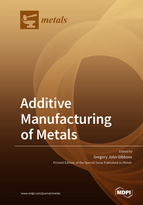Additive Manufacturing of Metals
A special issue of Metals (ISSN 2075-4701). This special issue belongs to the section "Additive Manufacturing".
Deadline for manuscript submissions: closed (31 December 2019) | Viewed by 64331
Special Issue Editor
Interests: additive manufacturing; rapid tooling; materials
Special Issues, Collections and Topics in MDPI journals
Special Issue Information
Dear Colleagues,
Metals Additive Manufacturing (AM) is a rapidly growing manufacturing capability. The cumulative annual growth of AM is predicted to exceed 20% CAGR for many years to come, reaching $9 billion in 2017 and expected to rise to over $63 billion by 2025. The metals (AM) market is particularly buoyant, rising 41% CAGR over 2010–2014. Current metal AM service market is £100 m, projected to reach £590 million by 2020 (CAGR of 31.5%), with increasing application in the aerospace and defense industry. Despite this remarkable rate of growth, there are significant challenges that are limiting the wider uptake and exploitation of metals AM, spanning across the entire metal AM supply chain. These include a lack of AM design and modelling skills and software, a gap in understanding in properties obtained from different machines and technologies, and an incomplete understanding of the causes of part quality variation and their effect on part failure. For this Special Issue in Metals we welcome reviews and articles in the areas of material supply, part design, process modelling, process technology, post-processing techniques and applications of metals AM.
Prof. Gregory John Gibbons
Guest Editor
Manuscript Submission Information
Manuscripts should be submitted online at www.mdpi.com by registering and logging in to this website. Once you are registered, click here to go to the submission form. Manuscripts can be submitted until the deadline. All submissions that pass pre-check are peer-reviewed. Accepted papers will be published continuously in the journal (as soon as accepted) and will be listed together on the special issue website. Research articles, review articles as well as short communications are invited. For planned papers, a title and short abstract (about 100 words) can be sent to the Editorial Office for announcement on this website.
Submitted manuscripts should not have been published previously, nor be under consideration for publication elsewhere (except conference proceedings papers). All manuscripts are thoroughly refereed through a single-blind peer-review process. A guide for authors and other relevant information for submission of manuscripts is available on the Instructions for Authors page. Metals is an international peer-reviewed open access monthly journal published by MDPI.
Please visit the Instructions for Authors page before submitting a manuscript. The Article Processing Charge (APC) for publication in this open access journal is 2600 CHF (Swiss Francs). Submitted papers should be well formatted and use good English. Authors may use MDPI's English editing service prior to publication or during author revisions.
Keywords
- metals additive manufacturing
- metal powders
- metallurgy
- design
- manufacturing
- thermal modelling
- mechanical modelling
- powder bed fusion
- directed energy deposition
- binder jetting






